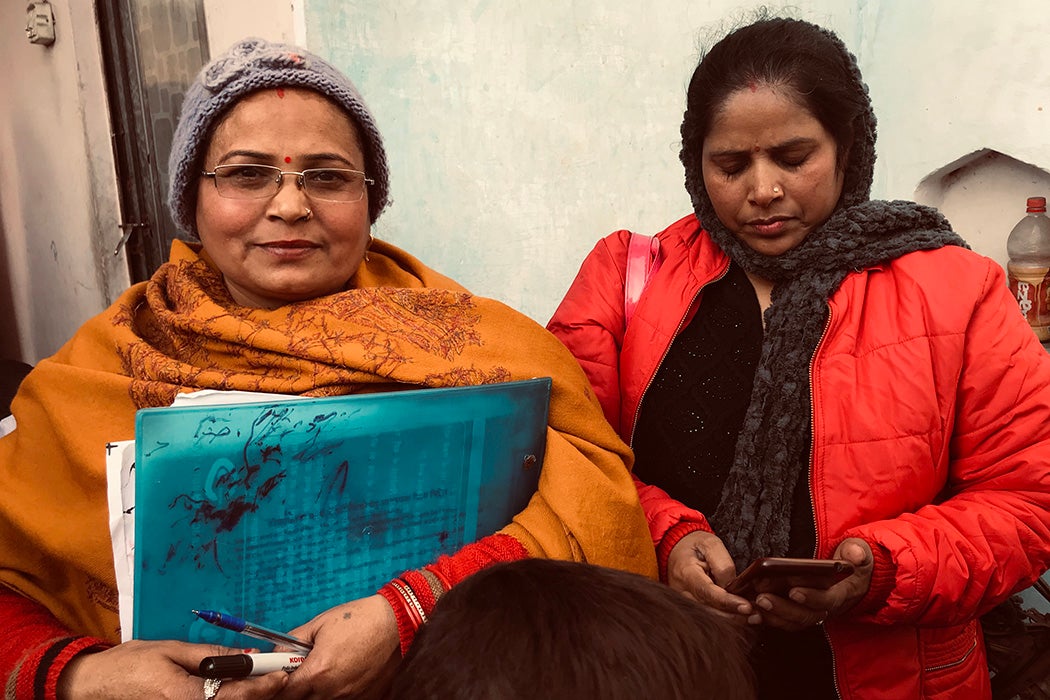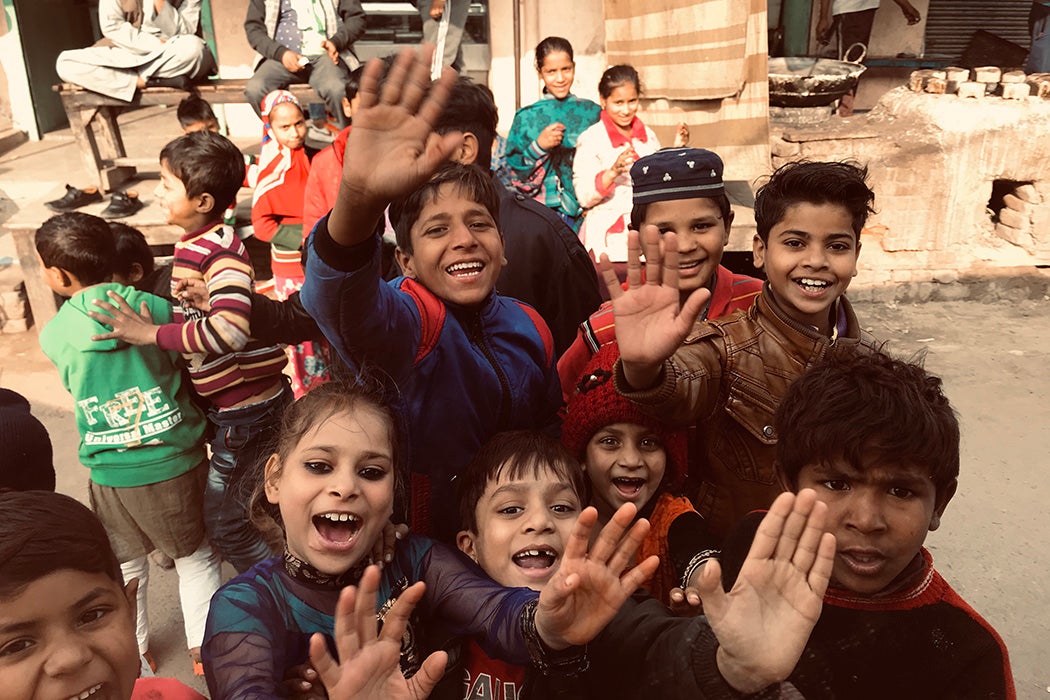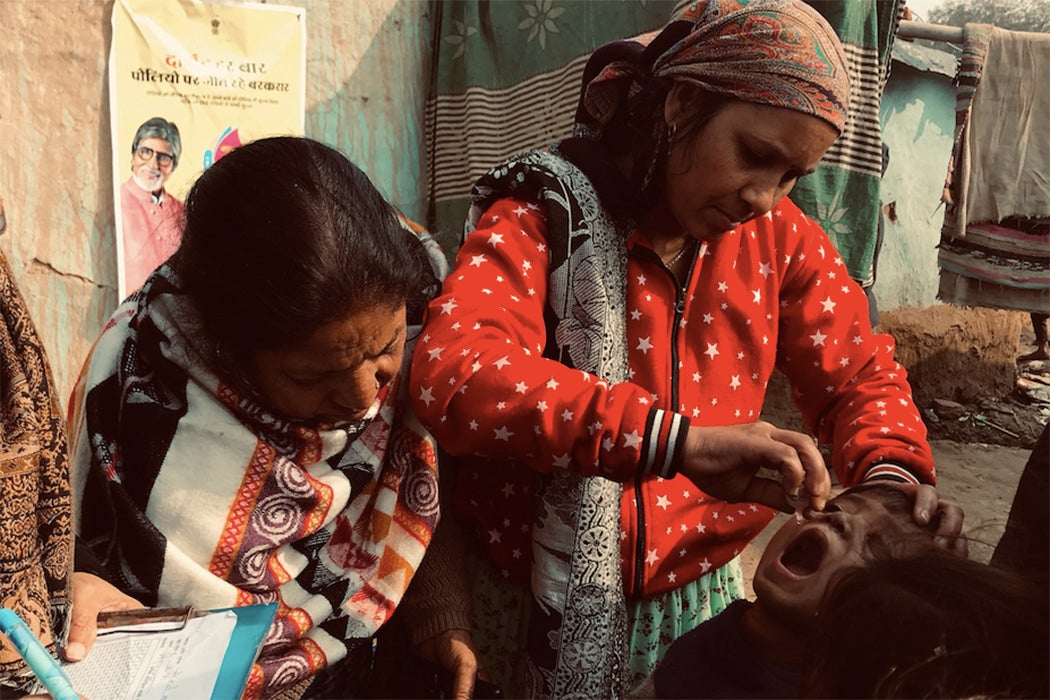Wrapped in a colorful yellow scarf, polio immunizer Rajbala stands among a vibrant crowd of parents and children, holding her records folder to her chest. Around her swirls a colorful chaos of mothers carrying their youngsters to get vaccinated against poliomyelitis—a viral disease that can attack the spinal cord, causing paralyses. Another immunizer, named Alka, holds a small bottle containing the oral polio vaccine over each child’s mouth and squeezes it slightly, making sure the two requisite drops make it right in. As one young mother walks off, an elderly woman with a baby takes her place. “This is my granddaughter,” she says proudly, squeezing the infant’s cheeks to get her mouth opened.
Weekly Newsletter
Rajbala, Alka and hundreds of their colleagues are administering these oral vaccines as part of India’s National Immunization Day (NID), a multi-day annual occurrence that usually takes place in January. Just this year alone, the country aimed to immunize over 174 million children under five years old against polio. Alka has been doing it for ten years, and Rajbala for 28. She still remembers how polio crippled people, leaving some unable to walk and only to crawl. Others couldn’t feed themselves or do any work, because their hands wouldn’t obey them. You can still find some adults who got paralyzed by polio in childhood, but today you rarely see kids afflicted by it—thanks to the country’s persistent vaccination efforts. That’s exactly why Rajbala and Alka stand at their immunization booth in Chandmari Jhuqq, an urban slum of Ghaziabad, a city in India’s state of Uttar Pradesh.

Rajbala remembers that when the vaccinations first started, people were afraid of them. They used to throw stones at the vaccinators. They pretended they weren’t home. They hid the children. Today, this doesn’t happen, but occasionally some residents do resist campaigns. This time around, some locals wouldn’t let the immunizers put their booth here, so the team had to ask the police for help. But the police didn’t apply force, Rajbala adds. They just reasoned with the people, and eventually the team was able to set up camp. In two days, they were able to vaccinate 163 children out of the 165 that Rajbala has on her list. If the remaining two don’t show up, the team will stop by their houses. They will go door to door, checking all the remaining households, making sure to vaccinate those kids whose parents didn’t make it to the booth—it’s crucial that there’s not a single child left.
In the 1980s, polio was endemic in India. Back then the world used to get about 1000 polio cases every day with India contributing half of them, says Deepak Kapur, India’s National PolioPlus Chair with Rotary International, an organization that works to eradicate polio. With 500 children being paralyzed daily, the picture was grim. In the United States, polio had once been a serious threat too—in 1937, schools were closing and parents were told to keep young children home and stay away from public gatherings to avoid catching it. In 1988, Rotary, World Health Organization, Center for Disease Control and UNICEF formed Global Polio Eradication Initiative or GPEI, aimed to eradicate polio. Later, the Bill & Melinda Gates Foundation and Gavi, the Vaccine Alliance joined in. Since then, GPEI reduced polio cases by 99.9 percent. After over two decades of efforts, India recorded its last polio case in January 2011, and was officially declared polio-free on March 27, 2014. But the virus is still circulating in the neighboring countries of Pakistan and Afghanistan and that’s why vaccination efforts can’t stop.
Polio is an environmental, waterborne disease associated with poverty, unsanitary conditions and lack of clean drinking water. The poliovirus replicates in the human intestines escaping into the environment with fecal matter. From there, polio can infect others through direct contact or drinking water. If a village is harboring polio, the one downstream from it will get it too. In India, where even in 2014 600 million people still lacked functioning toilets and many didn’t even have latrines, the issues of sanitation and clean drinking water remain pressing. The only way to eradicate polio here was to immunize every single child, which wasn’t an easy endeavor. But there are 69000 babies born in India every day, according to UNICEF’s 2018 estimate, and many of them live in hard to reach areas, where regular doctor check-ups and immunizations aren’t available even today, much less 30 years ago when eradication efforts first started.
“No one believed we could do it,” says Deepak Kapur, India’s National PolioPlus Chair with Rotary International, who was involved in the eradication efforts from early on. The prevalence of intestinal infections in India was the highest in the world, with Uttar Pradesh state, where Rajbala and Alka are working, leading the way—six times more than anywhere else on earth. Stopping an endemic enteric infection there was like trying to fill up a bottomless bucket, Kapur says. “We were called the Don Quixotes tempting the imaginary windmills,” he recalls, referring to a character from Miguel de Cervantes’s satirical novel that fancied himself a great worrier, getting embattled in ridiculous futile pursuits. “But we persevered,” Kapur says—and slowly things began to change.
Don Quixotes Versus Polio
In America, children receive an inactivated poliovirus vaccine (IPV), which is administered by injection at two months and then three more times at specific ages. The inactivated virus can’t replicate, but the immune system learns to recognize its genetic make-up and builds antibodies to destroy it. If it encounters the virus later in life, it immediately tears it to shreds. This structural, orderly type of immunization is called routine immunization.
The IPV vaccine is 100 efficient—no child in the world ever developed polio after receiving three doses of modern IPV. But it must be administered on a schedule and by a health professional who can use a syringe. That’s not always possible in many areas of the world. In India, where many settlements are located in the hard to reach areas—in the mountains, floodplains, or places with no roads—parents can’t bring their children for regular doctors’ visits. Some areas are only accessible by foot and others by raft, so doctors can’t regularly travel there either. Because the routine immunization can’t reach every child, India implemented a supplemental immunization with the oral polio vaccine (OPV.) Giving drops doesn’t require medical training and can be done by anyone—including volunteers from abroad, who travel with Rotary to India to help immunize young children. This system is called supplemental vaccination—because it supplements the routine efforts. India conducted its first supplemental immunization drive in 1995—and it keeps going. “Even today the routine immunization in India is hovering around 70 percent,” Kapur says. “That means that 30 percent of children are being missed, which is a huge number, if you add it year by year.”
But the OPV has its caveats. It uses a live, albeit attenuated, virus, which replicates in the gut until the body’s immunity system kills it—so for some time the children shed it in their stool. Once in the environment, this attenuated virus can mutate into a disease-casing wild type form that scientists call a circulating vaccine-derived poliovirus. This vaccine-derived virus can’t harm those that have been properly vaccinated, but can sicken and paralyze those who have not—and the Centers for Disease Control recorded quite a few of such cases. Therefore, when using OPV, all children must be vaccinated at the same time. Vaccinating one village now and another one later doesn’t work—at some point, the vaccinated one will pass the virus downstream, and an outbreak will happen.
That’s why supplemental vaccination happens as countrywide drives, usually over a few days. The vaccine bottles are shipped to all the remote locations in advance and kept refrigerated until it’s time to administer them. Every location relies on local volunteers and influencers to deliver the drops. About 150,000 Rotarians across India participate in the NID campaign in their respective regions, and over 300 Rotary volunteers from around the world come to help. It is a massive effort, says Mathew Varghese, who heads the orthopedics department at St. Stephen’s Hospital in New Delhi, where he operates on polio’s victims to restore whatever mobility is possible. “On NID days 225 million doses on polio day are distributed,” Varghese says. “It’s like vaccinating the entire United States.”
India’s Islamic communities were very suspicious of the vaccines at first—they worried that that drops made boys impotent and girls infertile. “There were rumors that vaccines were a conspiracy to reduce the minority population in India,” Kapur recalls—and also that the shots contained materials derived from pigs, which are banned by the Islamic religion. “That was absolute rubbish, but to debunk that rumor was quite a challenge.”
Even families with older children already paralyzed by polio, wouldn’t give drops to the younger ones. The Kundarki block in the City of Moradabad in Western Uttar Pradesh was a “polio capital of the world” and a hotbed of the resistance. When in 2002 Kapur’s Rotary team went into a house famous for its vaccine refusal, they passed by a polio-stricken boy playing in the mud outside. Inside, his mother was holding a little girl, still healthy—but her answer still makes Kapur cringe to this day.
“If you give her drops, I’ll hold her by her legs and dash her head against the wall,” the mother said. “And if I don’t do that, my husband will kill me.”
To overcome the problem, Rotary and UNICEF worked to build trust within the local communities. And that could differ from one community to another, says UNICEF’s immunization health specialist Bhrigu Kapuria. In some places people were suspicious because the government hadn’t paid attention to any of their needs or requests before. “You never built a road to our village, why do you show up now with the drops?” they wanted to know. They wanted the road first and drops later—so sometimes building the road did the trick. In other cases, UNICEF and Rotary mobilized the village teens who learned about health in school and took the message home. Kids and teenagers don’t have the suspicions and superstitions adults have, so they are more open to new ideas, and have the power to reshape the elders’ thinking. They also worked with journalists and government spokesmen to assure that any vaccine-related news were disseminated so that it didn’t instill fear but dispelled myths.
To overcome religious resistance, the agencies worked with the local religious leaders, Muslim and otherwise. We wanted to bring all religious leaders together to fight polio, Kapuria says. We wanted them to take the message back to their places of worship, be it mosques or bathing in the holy river. “We talked to them about two drops of life,” he says—and eventually the message sank in. During today’s immunization campaign, ulamas—Muslim religious leaders—add the call to vaccination to their daily calls for prayer. Some set up vaccinations booths right at the mosques.
As the Ghaziabad NID drive goes on, Mohammad Asjeed, a local ulama does exactly that—calls for prayer and immunization at the same time. When people tell him they have doubts about vaccinating, he tells them vaccines make their children healthy. “We don’t have polio because we vaccinate, and we must vaccinate because in Pakistan people still get sick with it,” he says. “You never know when the virus may cross the border, but when it does, you will be prepared. The two polio drops your children take will drown the virus.”
The Sewage Surveillance
City residents may not know when the virus might cross the border, but the environmental health officials have a way of finding out. Human-excreted pathogens end up in wastewater systems—and that’s where one can spot a poliovirus when it arrives. India works with WHO to maintain a robust environmental surveillance program via sewage sampling at specific locations. “This project is working across 52 sites in India in nines states,” explains Pankaj Bhatnagar, acting team lead with the WHO’s National Polio Surveillance Project in India. New Delhi has seven testing spots. “We are going to expand to Tamil Nadu in Chennai, so it will be 54 sites across 11 states.”
Every week team members put on gloves, rubber boots, and a mask and drop buckets into the sewage streams. When they gather the sample, they filter out the typical sewage debris, fill up special bottles and send them in insulated chilled containers to a lab. The scientists ran tests to comb the samples for polio presence.
The testing sites are chosen based on the urban catchment area from where they drain the sewage—typically the urban slums with high migratory population. In India, laborers and even families migrate seasonally—from one city or province to another. Some people migrate cross borders—from Pakistan and Afghanistan where children still get stricken by polio. But polio doesn’t leave every patient paralyzed—some people may never get any symptoms. In fact, 90 to 95 percent of polio cases are asymptomatic—paralysis occurs in only one percent of infections, so people can be shedding the virus, and not know it. “The metropolitan cities sometimes act as mixing bowls for people who are coming from different areas,” says Lucky Sangal, India’s technical officer for vaccine preventable disease laboratories. “They mix with the local people—and then it spreads.”

That’s why testing sewage for polio helps prevent the outbreaks before they happen. If a sewage sample tests positive, the health authorities immediately take action, including immunize all young children in the area drained by that sewage catchment. Moreover, medics can now tell where a specific virus came from.
As viruses procreate and evolve, they change their genomes slightly. Every time a poliovirus sample is diagnosed in a person in a particular geographic location, the medics enter its exact genetic characteristics into a global database. Over the three decades of eradicating efforts, health workers amassed a huge amount of information about the virus’ genetics and built the “polio family tree.” They can genetically match a polio found in a city’s sewage to the family tree and tell what province or country it actually came from. “It’s next to impossible to identify the person who is shedding the virus, but based on molecular genetics of the virus, we can tell where it came from,” says Sangal. She cites one case when polio showed up in Mumbai sewage years ago—and its genetic origin was traced to Bihar or Uttar Pradesh, which triggered immunization campaigns in affected regions. “We can inform the health official in that area so they can immunize the children there also.”
Surveying sewage for polio proves valuable for developed countries, too. In 2013, polio sewage tests in Israel revealed a circulating virus. When scientists investigated, they traced the positive samples to the Negev region of Israel, where many Bedouin communities live. Moreover, based on the virus’s genetics scientists were able to tell that it originated in Pakistan. Based on the findings, health authorities immunized the affected areas.
The Last Ward
Perhaps nowhere in India are polio’s crippling impact and eradication results more evident than in New Delhi’s St. Stephen’s hospital. Varghese has been doing reconstructive surgeries there for 30 years, and he still maintains separate male and female polio wards—about eight to ten patients in each. Over the years he had made thousands of restorative surgeries on children, making bones grow, returning twisted legs into the right position, and giving partial mobility to those who couldn’t use their legs. After surgeries and months of rehabilitation, the children would walk, many for the first time in their lives. They walked slowly, with a limp, with a cane—but it was still better than crawling.
Back in 1990, Varghese used to do about 600 polio surgeries a year and most of his patients were children. Now he only does 120 and his patients are adults ranging in age from 20s to 40s—men and women who got polio before vaccines became ubiquitous. Adults take longer to recover, so Varghese’s wards can fit fewer patients a year, but overall there are also fewer cases. Polio’s toll on India is diminishing—and if vaccinations continue, polio surgeries will one day become a thing of the past, just like the virus itself. “I look forward to the day my wards are empty,” Varghese says.







